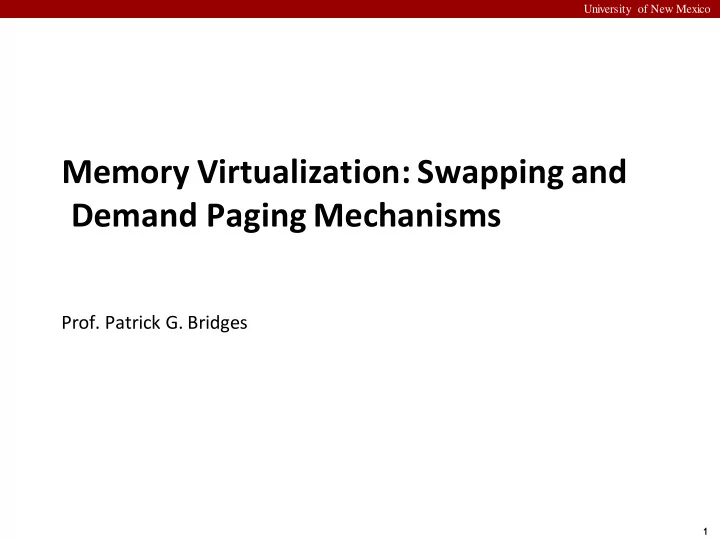

University of New Mexico Memory Virtualization: Swapping and Demand Paging Mechanisms Prof. Patrick G. Bridges 1
University of New Mexico Beyond Physical Memory: Mechanisms Require an additional level in the memory hierarchy. ▪ OS need a place to stash away portions of address space that currently aren’t in great demand. ▪ In modern systems, this role is usually served by a hard disk drive Registers Cache Main Memory Mass Storage( hard disk, tape, etc...) Memory Hierarchy in modern system 2
University of New Mexico Single large address for a process Always need to first arrange for the code or data to be in memory when before calling a function or accessing data. Beyond just a single process. ▪ The addition of swap space allows the OS to support the illusion of a large virtual memory for multiple concurrently-running process 3
Youjip Won 4 University of New Mexico Swap Space Reserve some space on the disk for moving pages back and forth. OS need to remember to the swap space, in page-sized unit PFN 0 PFN 1 PFN 2 PFN 3 Physical Proc 0 Proc 1 Proc 1 Proc 2 Memory [VPN 0] [VPN 2] [VPN 3] [VPN 0] Block 1 Block 2 Block 3 Block 4 Block 5 Block 6 Block 7 Block 0 Swap Proc 0 Proc 0 Proc 1 Proc 1 Proc 3 Proc 2 Proc 3 [Free] Space [VPN 1] [VPN 2] [VPN 0] [VPN 1] [VPN 0] [VPN 1] [VPN 1] Physical Memory and Swap Space 4
University of New Mexico Present Bit Add some machinery higher up in the system in order to support swapping pages to and from the disk. ▪ When the hardware looks in the PTE, it may find that the page is not present in physical memory. Value Meaning 1 page is present in physical memory 0 The page is not in memory but rather on disk. 5
University of New Mexico What If Memory Is Full ? The OS like to page out pages to make room for the new pages the OS is about to bring in. ▪ The process of picking a page to kick out, or replace is known as page-replacement policy 6
University of New Mexico The Page Fault Accessing page that is not in physical memory. ▪ If a page is not present and has been swapped disk, the OS need to swap the page into memory in order to service the page fault. 7
University of New Mexico Page Fault Control Flow PTE used for data such as the PFN of the page for a disk address. Operating System 3. Check storage whether page is exist. Secondary Storage 2.Trap 1. Reference Load M i 6. reinstruction Page Frame Page Frame Page Table 4. Get the page ... Page Frame 5. Reset Page Table. Page Frame Virtual Address When the OS receives a page fault, it looks in the PTE and issues the request to disk. 8
University of New Mexico Page Fault Control Flow – Hardware 1: VPN = (VirtualAddress & VPN_MASK) >> SHIFT 2: (Success, TlbEntry) = TLB_Lookup(VPN) 3: if (Success == True) // TLB Hit 4: if (CanAccess(TlbEntry.ProtectBits) == True) 5: Offset = VirtualAddress & OFFSET_MASK 6: PhysAddr = (TlbEntry.PFN << SHIFT) | Offset 7: Register = AccessMemory(PhysAddr) 8: else RaiseException(PROTECTION_FAULT) 9
University of New Mexico Page Fault Control Flow – Hardware 9: else // TLB Miss 10: PTEAddr = PTBR + (VPN * sizeof(PTE)) 11: PTE = AccessMemory(PTEAddr) 12: if (PTE.Valid == False) 13: RaiseException(SEGMENTATION_FAULT) 14: else 15: if (CanAccess(PTE.ProtectBits) == False) 16: RaiseException(PROTECTION_FAULT) 17: else if (PTE.Present == True) 18: // assuming hardware-managed TLB 19: TLB_Insert(VPN, PTE.PFN, PTE.ProtectBits) 20: RetryInstruction() 21: else if (PTE.Present == False) 22: RaiseException(PAGE_FAULT) 10
University of New Mexico Page Fault Control Flow – Software 1: PFN = FindFreePhysicalPage() 2: if (PFN == -1) // no free page found 3: PFN = EvictPage() // run replacement algorithm 4: DiskRead(PTE.DiskAddr, pfn) // sleep (waiting for I/O) 5: PTE.present = True // update page table with present 6: PTE.PFN = PFN // bit and translation (PFN) 7: RetryInstruction() // retry instruction The OS must find a physical frame for the soon-be-faulted-in page to reside within. If there is no such page, waiting for the replacement algorithm to run and kick some pages out of memory. 11
University of New Mexico When Replacements Really Occur OS waits until memory is nearly full, and only then replaces a page to make room for some other page ▪ This is a little bit unrealistic, and there are many reason for the OS to keep a small portion of memory free more proactively. ▪ Generally keep a low water mark and a high water mark on number of free physical pages desired Swap Daemon, Page Daemon ▪ There are fewer than LW pages available, a background thread that is responsible for freeing memory runs. ▪ The thread evicts pages until there are HW pages available. 12
Recommend
More recommend